Unveiling the 4 Essential Elements of a Profitable Steal from the Small Blind
One of the crucial situations in poker that significantly influences your overall winnings is the blind stealing scenario from the Small Blind. It arises when you are in the Small Blind position, and all players before you have folded.
In this scenario, novice players often struggle by becoming too absorbed in their own cards instead of examining their opponent’s playing tendencies from the Big Blind. This common oversight frequently results in missed chances to successfully steal the blinds, even when holding a weak hand.
Let’s simulate this spot in Hand2Note 4, selecting only marginal and weak starting hands in the preflop matrix and observe the Action Profit of a steal.
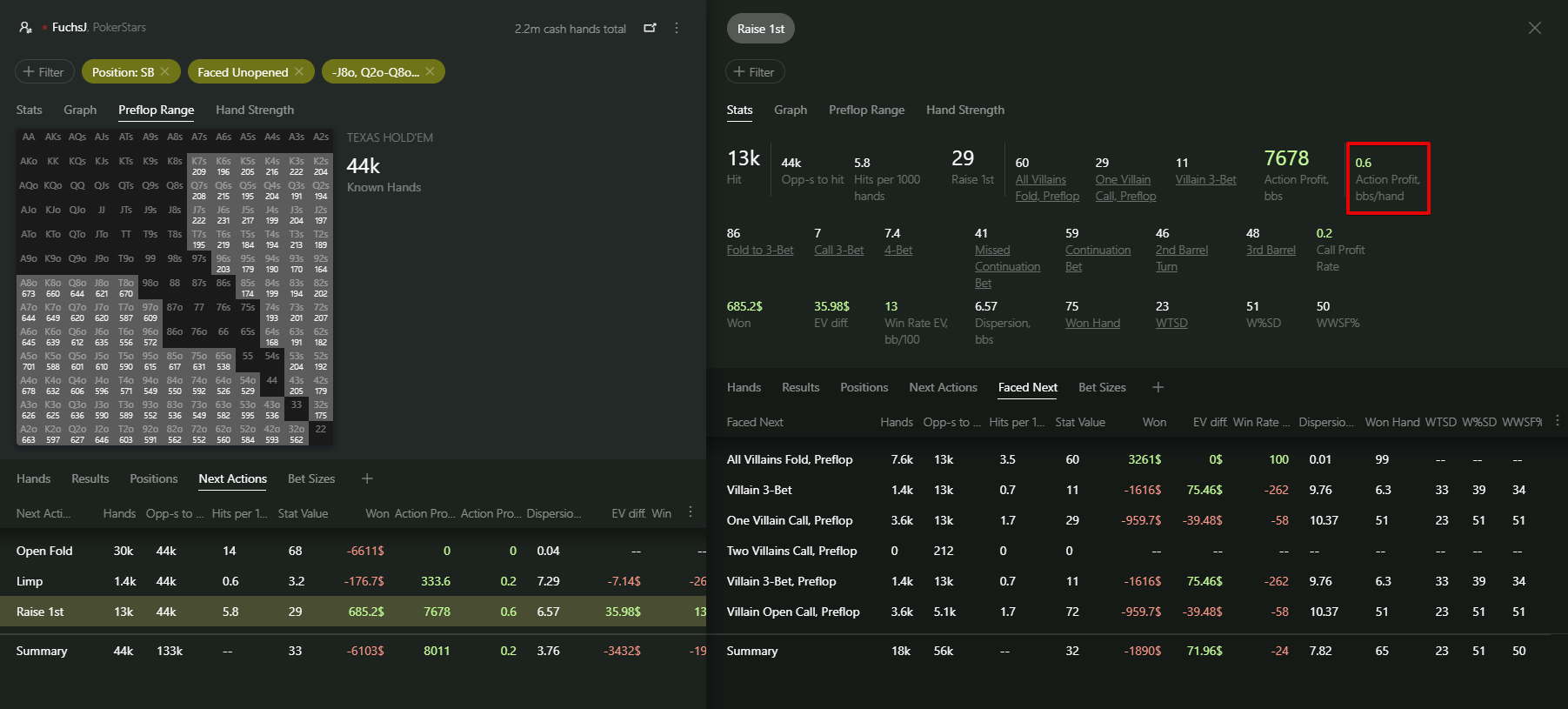
Throughout my playing history, I executed the steal from the Small Blind with such hands 13,000 times, averaging around 0.6 big blinds per hand. In this situation, my cumulative winnings reached 7,678 big blinds. Undoubtedly, this is much better than consistently giving away the small blind in such a spot.
So, does this mean you can simply steal from the Small Blind every time with any hand?
Unfortunately, it’s not that simple. In this article, we’ll discuss four crucial factors you need to take into consideration for successful blind stealing.
# Evaluate how often your opponent on the Big Blind folds to a steal.
The primary and paramount aspect to analyze when planning an attack from the Small Blind is the frequency with which your opponent on the Big Blind folds to a steal.
In Hand2Note 4, a specific stat, BB Fold vs Steal, addresses this situation. The higher this value in your opponent’s HUD, the wider your steal range should be.
Let’s consider an example:

On the Small Blind, we were dealt K6 offsuit, and all players before us folded. A lot of players would just give up with such a mediocre hand without a second thought. However, it’s essential to remember that in a stealing situation, our hand strength is not the primary factor, and sometimes it’s not important at all.
Let’s open the pop-up for our opponent and see how often they fold on the Big Blind.
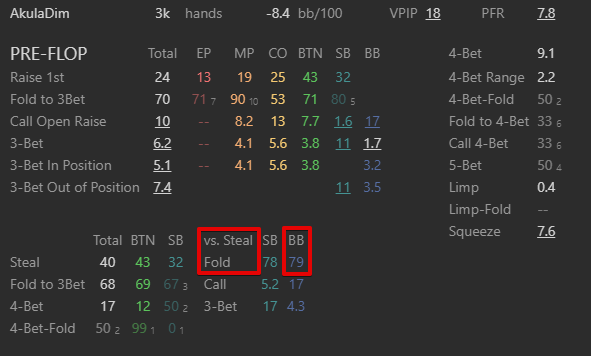
As we can see, our opponent doesn’t seem to care much about defending their big blind and folds to the steal in 79% of cases. Knowing this information, pressing the "Fold" button and giving up our small blind to such a player would be a crime against our winrate!
We should exploit such straightforward players as this one, and stealing from the Small Blind with any two cards will be a highly profitable strategy in the long run.
# Pay attention to your opponent’s playing style.
Certainly, the BB Fold vs Steal stat is a reliable indicator for successful blind stealing. However, to rely on it, you’ll need a substantial sample size on your opponent, as situations where all players fold before the Small Blind are not so common. So what do you do if your HUD doesn’t provide much information on the player to your left?
You can rely on the VPIP stat to determine how selectively your opponent plays their hands. This stat becomes reliable relatively quickly as it updates after each hand.
Tight players often give up their big blind without a fight, while loose players hate folding. They will actively defend their big blind with calls and re-raises, causing you a lot of trouble.
Let’s track this tendency using Multi-player reports in Hand2Note 4. This feature allows you to identify common patterns in the gameplay of players with similar styles and develop exploitative strategies against them.
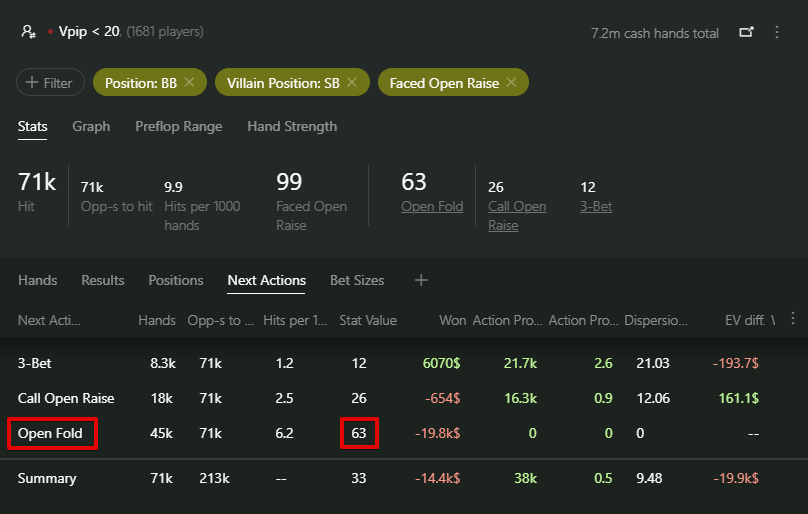
For the report, I selected tight players with a VPIP indicator of no more than 20, each of whom has a minimum of 1000 hands in my database. This is a reliable sample that accurately reflects players’ tendencies.
Then, using filters, I identified situations where these players were in the Big Blind and faced a raise from the Small Blind. Next, I clicked on the “Next Actions” tab to see what subsequent actions they took and at what frequency.
In the screenshot above, we observe that tight players, on average, give up their Big Blind in 63% of cases, which is quite frequent.
Now let’s pin the obtained report and create a similar one for loose players by setting the VPIP filter to 30 or higher, and then compare the reports side by side.

We can make sure that loose players indeed defend their big blind much more persistently, folding to a steal from the Small Blind only in 40% of cases.
Thus, the lower your opponent’s VPIP, the more often you should attempt to take their big blind. However, when dealing with loose players, it’s advisable to choose better hands for the steal.
# Vary Your Raise Sizes
Many players consistently use the same raise sizes preflop, aiming for balance. While there is a certain logic in this approach, it may not be the most profitable strategy in practice.
The reason is that players typically react differently to various raise sizes, being less willing to defend against larger raises.
Smart reports in Hand2Note 4 are designed to provide you with all the necessary information at your fingertips. Let’s go back to the report we obtained on tight players and click on the “Bet Sizes” tab to find out how opponents react to different raise sizes:
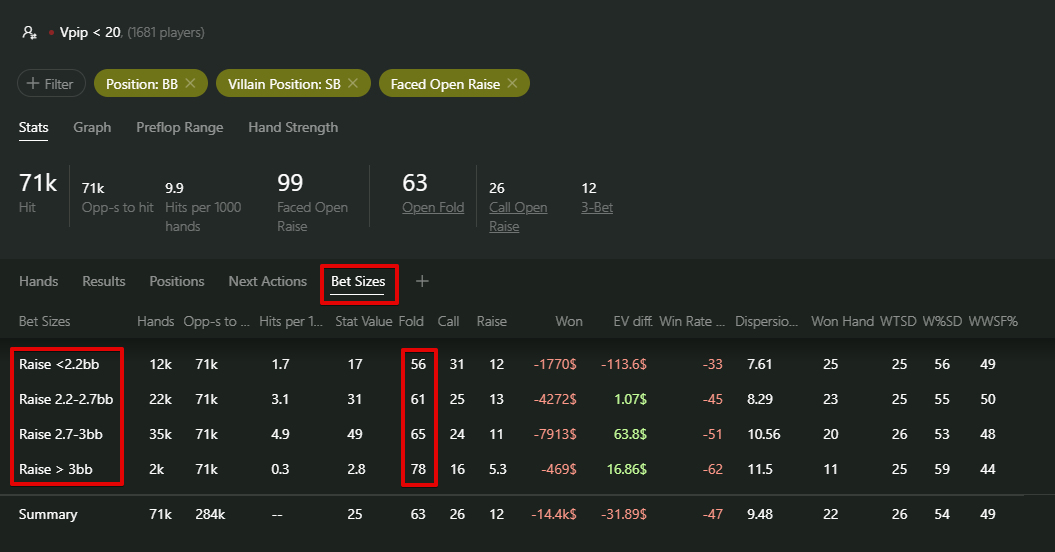
We can observe a linear trend: the larger the raise from the Small Blind, the more often players give up their Big Blind without a fight.
Accordingly, when attempting to steal the blind, it makes sense to increase the size of your raise. Moreover, in general, opening with a small raise, thereby giving your opponent a good price when they play in position, is clearly not in your best interest.
# Estimate how often your opponent folds to a continuation bet on the flop.
If the player on the Big Blind doesn’t fold often to a steal, it’s not yet a reason to abandon blind stealing attempts. Many players call preflop with a wide range of hands but play very straightforwardly on the flop, folding to a continuation bet whenever they don’t have a strong hand.
We can exploit such opponents from the Small Blind as well. If they defend their Big Blind with a wide range, they will hit the flop infrequently. Therefore, you can win many small pots by putting pressure on them on the flop.
Let’s examine a suitable situation for a steal:
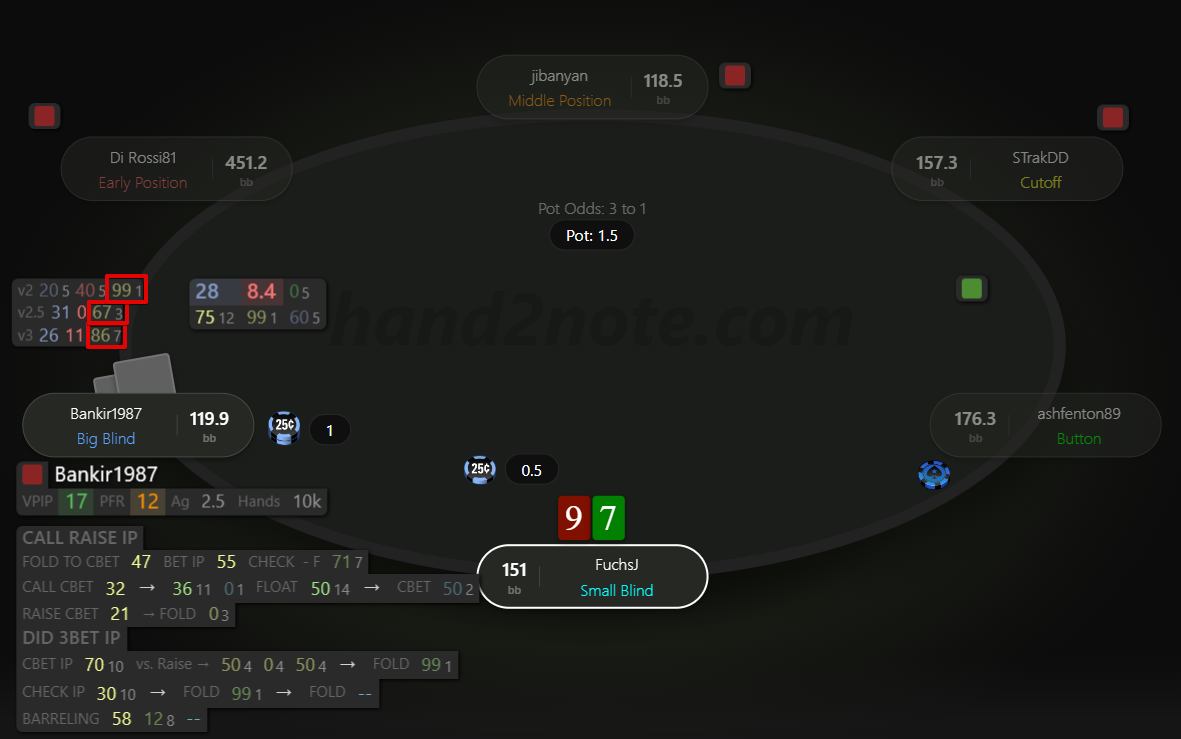
We have 97 offsuit on the Small Blind, and all the players before us folded. Our hand is quite marginal, especially for playing out of position, but, instead of quick folding, let’s first study the opponent’s tendencies.
The dynamic HUD of Hand2Note 4 shows us that in the blind battle, our opponent often folds to a continuation bet on the flop, regardless of the preflop raise size. Therefore, it’s definitely worth making a move with a plan to take the pot with a bet on any flop.
A steal from the Small Blind is an important strategic element in poker, allowing you to minimize losses from this position. To effectively use this technique, it’s crucial not only to evaluate your own cards but also to understand the style and characteristics of your opponent’s play from the Big Blind.
Leveraging the full analytical power of Hand2Note 4, you can effortlessly spot favorable opponents and discover opportunities for successful blind stealing.
# Unveiling the 4 Essential Elements of a Profitable Steal from the Small Blind
One of the crucial situations in poker that significantly influences your overall winnings is the blind stealing scenario from the Small Blind. It arises when you are in the Small Blind position, and all players before you have folded.
In this scenario, novice players often struggle by becoming too absorbed in their own cards instead of examining their opponent’s playing tendencies from the Big Blind. This common oversight frequently results in missed chances to successfully steal the blinds, even when holding a weak hand.
Let’s simulate this spot in Hand2Note 4, selecting only marginal and weak starting hands in the preflop matrix and observe the Action Profit of a steal.

Throughout my playing history, I executed the steal from the Small Blind with such hands 13,000 times, averaging around 0.6 big blinds per hand. In this situation, my cumulative winnings reached 7,678 big blinds. Undoubtedly, this is much better than consistently giving away the small blind in such a spot.
So, does this mean you can simply steal from the Small Blind every time with any hand?
Unfortunately, it’s not that simple. In this article, we’ll discuss four crucial factors you need to take into consideration for successful blind stealing.
# Evaluate how often your opponent on the Big Blind folds to a steal.
The primary and paramount aspect to analyze when planning an attack from the Small Blind is the frequency with which your opponent on the Big Blind folds to a steal.
In Hand2Note 4, a specific stat, BB Fold vs Steal, addresses this situation. The higher this value in your opponent’s HUD, the wider your steal range should be.
Let’s consider an example:

On the Small Blind, we were dealt K6 offsuit, and all players before us folded. A lot of players would just give up with such a mediocre hand without a second thought. However, it’s essential to remember that in a stealing situation, our hand strength is not the primary factor, and sometimes it’s not important at all.
Let’s open the pop-up for our opponent and see how often they fold on the Big Blind.

As we can see, our opponent doesn’t seem to care much about defending their big blind and folds to the steal in 79% of cases. Knowing this information, pressing the "Fold" button and giving up our small blind to such a player would be a crime against our winrate!
We should exploit such straightforward players as this one, and stealing from the Small Blind with any two cards will be a highly profitable strategy in the long run.
# Pay attention to your opponent’s playing style.
Certainly, the BB Fold vs Steal stat is a reliable indicator for successful blind stealing. However, to rely on it, you’ll need a substantial sample size on your opponent, as situations where all players fold before the Small Blind are not so common. So what do you do if your HUD doesn’t provide much information on the player to your left?
You can rely on the VPIP stat to determine how selectively your opponent plays their hands. This stat becomes reliable relatively quickly as it updates after each hand.
Tight players often give up their big blind without a fight, while loose players hate folding. They will actively defend their big blind with calls and re-raises, causing you a lot of trouble.
Let’s track this tendency using Multi-player reports in Hand2Note 4. This feature allows you to identify common patterns in the gameplay of players with similar styles and develop exploitative strategies against them.

For the report, I selected tight players with a VPIP indicator of no more than 20, each of whom has a minimum of 1000 hands in my database. This is a reliable sample that accurately reflects players’ tendencies.
Then, using filters, I identified situations where these players were in the Big Blind and faced a raise from the Small Blind. Next, I clicked on the “Next Actions” tab to see what subsequent actions they took and at what frequency.
In the screenshot above, we observe that tight players, on average, give up their Big Blind in 63% of cases, which is quite frequent.
Now let’s pin the obtained report and create a similar one for loose players by setting the VPIP filter to 30 or higher, and then compare the reports side by side.

We can make sure that loose players indeed defend their big blind much more persistently, folding to a steal from the Small Blind only in 40% of cases.
Thus, the lower your opponent’s VPIP, the more often you should attempt to take their big blind. However, when dealing with loose players, it’s advisable to choose better hands for the steal.
# Vary Your Raise Sizes
Many players consistently use the same raise sizes preflop, aiming for balance. While there is a certain logic in this approach, it may not be the most profitable strategy in practice.
The reason is that players typically react differently to various raise sizes, being less willing to defend against larger raises.
Smart reports in Hand2Note 4 are designed to provide you with all the necessary information at your fingertips. Let’s go back to the report we obtained on tight players and click on the “Bet Sizes” tab to find out how opponents react to different raise sizes:

We can observe a linear trend: the larger the raise from the Small Blind, the more often players give up their Big Blind without a fight.
Accordingly, when attempting to steal the blind, it makes sense to increase the size of your raise. Moreover, in general, opening with a small raise, thereby giving your opponent a good price when they play in position, is clearly not in your best interest.
# Estimate how often your opponent folds to a continuation bet on the flop.
If the player on the Big Blind doesn’t fold often to a steal, it’s not yet a reason to abandon blind stealing attempts. Many players call preflop with a wide range of hands but play very straightforwardly on the flop, folding to a continuation bet whenever they don’t have a strong hand.
We can exploit such opponents from the Small Blind as well. If they defend their Big Blind with a wide range, they will hit the flop infrequently. Therefore, you can win many small pots by putting pressure on them on the flop.
Let’s examine a suitable situation for a steal:

We have 97 offsuit on the Small Blind, and all the players before us folded. Our hand is quite marginal, especially for playing out of position, but, instead of quick folding, let’s first study the opponent’s tendencies.
The dynamic HUD of Hand2Note 4 shows us that in the blind battle, our opponent often folds to a continuation bet on the flop, regardless of the preflop raise size. Therefore, it’s definitely worth making a move with a plan to take the pot with a bet on any flop.
A steal from the Small Blind is an important strategic element in poker, allowing you to minimize losses from this position. To effectively use this technique, it’s crucial not only to evaluate your own cards but also to understand the style and characteristics of your opponent’s play from the Big Blind.
Leveraging the full analytical power of Hand2Note 4, you can effortlessly spot favorable opponents and discover opportunities for successful blind stealing.















